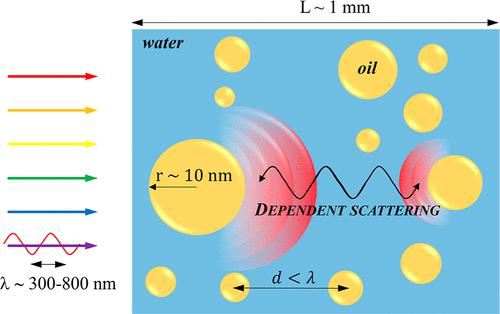当前位置:
X-MOL 学术
›
J. Phys. Chem. C
›
论文详情
Our official English website, www.x-mol.net, welcomes your feedback! (Note: you will need to create a separate account there.)
Rigorous Accounting for Dependent Scattering in Thick and Concentrated Nanoemulsions
The Journal of Physical Chemistry C ( IF 3.7 ) Pub Date : 2024-04-08 , DOI: 10.1021/acs.jpcc.3c08072 Ricardo Martinez 1 , Abhinav Bhanawat 1 , Refet Ali Yalçin 2 , Laurent Pilon 1, 3, 4
The Journal of Physical Chemistry C ( IF 3.7 ) Pub Date : 2024-04-08 , DOI: 10.1021/acs.jpcc.3c08072 Ricardo Martinez 1 , Abhinav Bhanawat 1 , Refet Ali Yalçin 2 , Laurent Pilon 1, 3, 4
Affiliation

|
Concentrated and thick oil-in-water nanoemulsions have been observed to become more transparent with increasing oil volume fraction. This study demonstrates rigorously experimentally and numerically that such unusual behavior is due to dependent scattering including not only far-field but also near-field effects. Indeed, when the droplet concentration is sufficiently large, their interparticle distance becomes small compared to the wavelength of light and scattering by a given droplet may be affected by the proximity of others. This situation is referred to as dependent scattering. Light transfer through nanoemulsions and other colloids has previously been modeled by solving the radiative transfer equation accounting for dependent scattering using the static structure factor based on far-field approximations. Here, oil-in-water nanoemulsions were prepared with oil volume fraction ranging between 1 and 20% and a peak droplet radius of 16 nm. The spectral normal–hemispherical transmittance of the different nanoemulsions in 10 mm thick cuvettes was measured experimentally between 400 and 900 nm. Numerical predictions for nonoverlapping randomly distributed nanoscale oil droplets in water and accounting for dependent scattering including near-field effects─using the recently developed radiative transfer with reciprocal transactions (R2T2) method─were in excellent agreement with experimental measurements. Simulations revealed that assuming independent scattering underestimated the normal–hemispherical transmittance even for a relatively small oil volume fraction. Additionally, simulations using the dense medium radiative transfer (DMRT) and static structure factor predicted that dependent scattering prevailed for oil volume fractions slightly greater than those predicted by the R2T2 method. Interestingly, the DMRT method predicted large increases in transmittance when the oil droplet size and volume fraction were larger than 10 nm and 10%, respectively. Finally, simulations also revealed that dependent scattering enables the design of oil-in-water nanoemulsions to backscatter or absorb light by tuning the oil droplet size and volume fraction. The results validate that the R2T2 method could be used to characterize nanoemulsions or to investigate their formation, composition, and stability for drug delivery, food, and cosmetics applications. Future studies could extend the use of the R2T2 method to colloidal suspensions with particles of arbitrary shapes and to radiation transfer of polarized light in turbid media.
中文翻译:

严格计算浓稠纳米乳液中的相关散射
据观察,随着油体积分数的增加,浓稠的水包油纳米乳液变得更加透明。这项研究通过严格的实验和数值证明,这种不寻常的行为是由于相关散射造成的,不仅包括远场效应,还包括近场效应。事实上,当液滴浓度足够大时,它们的颗粒间距离与光的波长相比会变小,并且给定液滴的散射可能会受到其他液滴附近的影响。这种情况称为相关散射。先前通过使用基于远场近似的静态结构因子求解辐射传输方程来对通过纳米乳液和其他胶体的光传输进行建模,该方程考虑了相关散射。在此,制备了油体积分数在 1% 至 20% 之间、峰值液滴半径为 16 nm 的水包油纳米乳液。在 10 mm 厚的比色皿中,通过实验测量了 400 至 900 nm 之间不同纳米乳液的光谱法向半球透射率。对水中非重叠随机分布的纳米级油滴的数值预测以及对包括近场效应在内的相关散射的解释(使用最近开发的相互交易辐射传输(R 2 T 2)方法)与实验测量结果非常一致。模拟表明,即使对于相对较小的油体积分数,假设独立散射也会低估法向半球透射率。此外,使用致密介质辐射传输 (DMRT) 和静态结构因子进行的模拟预测,油体积分数的相关散射占主导地位,略大于 R 2 T 2方法预测的值。有趣的是,当油滴尺寸和体积分数分别大于 10 nm 和 10% 时,DMRT 方法预测透射率会大幅增加。最后,模拟还表明,相关散射使得水包油纳米乳液的设计能够通过调整油滴尺寸和体积分数来反向散射或吸收光。结果验证了 R 2 T 2方法可用于表征纳米乳液或研究其在药物输送、食品和化妆品应用中的形成、组成和稳定性。未来的研究可以将 R 2 T 2方法的使用扩展到具有任意形状颗粒的胶体悬浮液以及浑浊介质中偏振光的辐射传输。
更新日期:2024-04-08
中文翻译:

严格计算浓稠纳米乳液中的相关散射
据观察,随着油体积分数的增加,浓稠的水包油纳米乳液变得更加透明。这项研究通过严格的实验和数值证明,这种不寻常的行为是由于相关散射造成的,不仅包括远场效应,还包括近场效应。事实上,当液滴浓度足够大时,它们的颗粒间距离与光的波长相比会变小,并且给定液滴的散射可能会受到其他液滴附近的影响。这种情况称为相关散射。先前通过使用基于远场近似的静态结构因子求解辐射传输方程来对通过纳米乳液和其他胶体的光传输进行建模,该方程考虑了相关散射。在此,制备了油体积分数在 1% 至 20% 之间、峰值液滴半径为 16 nm 的水包油纳米乳液。在 10 mm 厚的比色皿中,通过实验测量了 400 至 900 nm 之间不同纳米乳液的光谱法向半球透射率。对水中非重叠随机分布的纳米级油滴的数值预测以及对包括近场效应在内的相关散射的解释(使用最近开发的相互交易辐射传输(R 2 T 2)方法)与实验测量结果非常一致。模拟表明,即使对于相对较小的油体积分数,假设独立散射也会低估法向半球透射率。此外,使用致密介质辐射传输 (DMRT) 和静态结构因子进行的模拟预测,油体积分数的相关散射占主导地位,略大于 R 2 T 2方法预测的值。有趣的是,当油滴尺寸和体积分数分别大于 10 nm 和 10% 时,DMRT 方法预测透射率会大幅增加。最后,模拟还表明,相关散射使得水包油纳米乳液的设计能够通过调整油滴尺寸和体积分数来反向散射或吸收光。结果验证了 R 2 T 2方法可用于表征纳米乳液或研究其在药物输送、食品和化妆品应用中的形成、组成和稳定性。未来的研究可以将 R 2 T 2方法的使用扩展到具有任意形状颗粒的胶体悬浮液以及浑浊介质中偏振光的辐射传输。



























 京公网安备 11010802027423号
京公网安备 11010802027423号